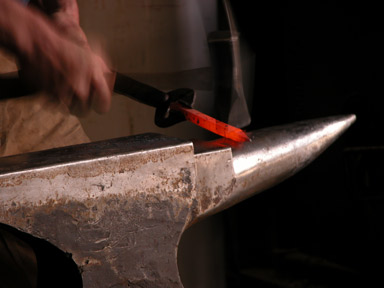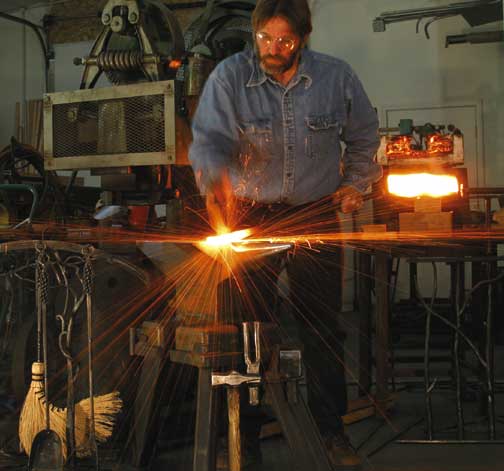

NRBA Spring 2007 Conference --- May 18 - 20.
Tom Holcombe's Sore Elbow Forge, 955 Story Mill Road, Bozeman, Montana

Gilmore
Metalsmithing
Glenn Gilmore
By Rafael Routson
"Glenn Gilmore forges his intentions in iron, applying his attention to detail, his love of design, and his artistic endeavors to create his pieces."
The town of Hamilton, Montana, lies south of Missoula on Highway 93, the road that crosses four states and ends near the border of Mexico. The Bitterroot and Sapphire ranges lie frosted in snow and veiled in transitional winter storm clouds, the nights freezing thin white icing to the streets of the town, snow drifting into the steady current of the Bitterroot River. In the narrow valley, dead weeds and winter grass tinge the lower hills in the thick blonds and browns of a coyote skin. Glenn Gilmore has his large, tin shop that doubles as a house, out a few miles from town, the metal building set on the hills and low grasses where the cold winds take wisps and shake bare arms of the few thin trees.
Glenn makes fireplace doors, screens, and accessories, light fixtures, lamps, decorative hardware, wrought iron tables, fences, gates, railings and other architectural ironwork for an international clientele. His fireplace designs hold a high degree of creativity and diversity. He has created fireplace doors with fleur-de-lis, repousséed copper dog and pheasant heads; three-dimensional forest scenes with oak leaves, pine cones, or animals; forged iron vines and roses; and abstract designs. He uses many traditional techniques to forge his ironwork; his background of blacksmithing gives him an ease with mortise and tenon, riveting and collaring, but his style is distinct and contemporary. he speaks about the balance of mass and elegance in steel, how the eye sees and adjusts the design, how to offset twists, and use larger or smaller bar stock to achieve an effect that is visually pleasing. His ironwork attains the appearance of being neither too massive nor too delicate, but striking and proportional to the setting.
Glenn was born in Pataski, Michigan, and spent his childhood moving across the United States. His father was a teacher, and sought work in Arizona, Michigan, Kansas and New Mexico. His father came from a ranching and farming background, and Glenn had an early interest in agriculture, mechanics, and working with his hands. He worked carpentry and traveled. He returned to New Mexico to work on ranches, finding a passion for horses which led him to take classes at the Wolverine Farrier School. His first introduction to forge work came through the shaping, creasing, punching, and forge welding of horseshoes.
A few years later a friend urged Glenn to attend an ABANA, Artist-Blacksmith's Association of North America, conference. Here he met Francis Whitaker, and saw a brochure for the John C. Campbell Folk School in Brasstown, North Carolina, where Francis was going to be teaching a workshop. Glenn signed up for the workshop, one held in an old milking barn with few tools. During the class, Francis bought a couple more firepots and accumulated tools for subsequent workshops. The students had an auction at the end to raise money for the shop. The events redirected Glenn's creative and artistic tendencies to the medium of iron, and he returned several years following to attend classes at the school. the classes inspired and shaped his work as a blacksmith, the precise instruction of Francis providing the framework from which he would develop his own style, the school providing a space to which he would later return as resident blacksmith and teacher.
Glenn moved from Michigan to New Mexico, raced and repaired bicycles, shod horses, and started taking his blacksmithing work to arts and crafts fairs. He took jewelry and machine shop classes. He worked as a teacher of blacksmithing and glass blowing in a craft village at the Silver Dollar City theme park. He received a Creative Artist's Grant from the Michigan Council for the Arts to pursue his interests in Damascus steel. In 1984, he attended an ABANA conference in Wisconsin, where he heard about a program that sponsored blacksmiths to travel to Germany. having taken several classes with Francis Whitaker, who carried a strong German influence, Glenn was interested in studying in Germany. he spent four months at the International Teaching Center for Metal Design and the Vulkanschmiede in the city of Aachen, working with the artist-blacksmith Manfred Bredohl, and witnessing the iron craftsmanship of Europe. He traveled to see the Belgian Damascus gun barrels, and other forges and museums in Germany. The lines and angularity of Germany style, the reinforcing and learning of traditional techniques, the exposure to centuries of blacksmithing shaped his own career as a metal smith and artist.
Glenn moved to North Carolina to be the Resident Blacksmith at the John C. Campbell Folk school, where he recruited instructors, people who were both good blacksmiths and good teachers. He maintained the teaching facility, gave demonstrations, and taught a a few classes. He worked there for two years, and then built his own forge in Brasstown, six miles from the school, where he started taking more of his own commission work. In the foothills of the Smoky Mountains, with thick deciduous forests and a long dirt driveway leading to the shop, Glenn worked hard to establish his place as an artist, designer and smith of iron. He married and raised two stepchildren. He gave demonstrations and forged ironwork for galleries, stores, museums, commercial buildings, and private homes.
After 15 years in Brasstown, Glenn packed his entire forge into shipping crates and moved to a place outside of Hamilton, Montana. Ranges of mountains run on two sides, where elk and moose stamp posthole tracks into drifts of snow, where one can hike or cross country ski, and be high in the timber within a few minutes of driving. here he forges architectural ironwork in the big, tin shop, insulated from the Montana winds. He forges his intentions in iron, applying his attention to detail, his love of design, and his artistic endeavors to create his pieces.
Reprinted from:
A Heritage in Iron
© 2004 Rafael Routson
Double Shoe Publishing Company
970-240-3822 Phone
970-240-3823 Fax
Email: parker@doubleshoe.com
And, In Glenn's
Words:
I have been very fortunate in being able to do
my own design work, whether for commissions or myself.
This has allowed me to create challenges in the work for my continual growth and
self expression.
I enjoy using bold clean lines in my designs, always striving for a balance
between mass, form and function.
I want the piece to have enough body that it will stand on it's own, yet not be
lost or feel overwhelming.
I enjoy hot forging the metal because it is a very direct process. When I want a
desired form I have to know where and how to hit the metal and with each hammer
blow it moves in the desired direction. It is hard work and I put a great deal
of attention into creating visually pleasing objects. It is a big part of my
life and I love doing it.
Whether forging a set of large driveway gates or a small coat hook, all the
elements need to be in balance with one another.
One of the important design concepts in my work is the method I use to join
different elements together. I often use traditional methods of joinery, rivets,
collars, mortise and tenon. Though these are traditional methods, I create
contemporary pieces using them.
These methods not only provide an important part of the overall design, but add
structural integrity to the work.
Northern Rockies Blacksmith Association. 415 St. Mary's Road, Stevensville, MT 59870 406 531-0211 sbolinge@aol.com
NRBA Home Blacksmith News Board of Directors Past Conferences Future Conferences Library Touchmarks Membership Application
Web design: morris@hallowellco.com